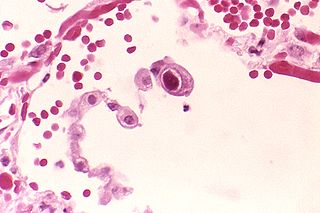
Cytomegalovirus (CMV) is a genus of viruses in the order Herpesvirales, in the family Herpesviridae, in the subfamily Betaherpesvirinae. Humans and monkeys serve as natural hosts. The eight species in this genus include the type species, Human betaherpesvirus 5, which is the species that infects humans. Diseases associated with HHV-5 include mononucleosis, and pneumonia. In the medical literature, most mentions of CMV without further specification refer implicitly to human CMV. Human CMV is the most studied of all cytomegaloviruses.
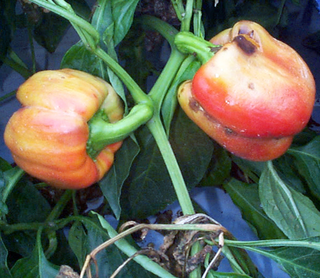
Plant viruses are viruses that affect plants. Like all other viruses, plant viruses are obligate intracellular parasites that do not have the molecular machinery to replicate without a host. Plant viruses can be pathogenic to higher plants.

Geminiviridae is a family of plant viruses that encode their genetic information on a circular genome of single-stranded (ss) DNA. There are currently 485 species in this family, divided among 9 genera. Diseases associated with this family include: bright yellow mosaic, yellow mosaic, yellow mottle, leaf curling, stunting, streaks, reduced yields. They have single-stranded circular DNA genomes encoding genes that diverge in both directions from a virion strand origin of replication. According to the Baltimore classification they are considered class II viruses. It is the largest known family of single stranded DNA viruses.
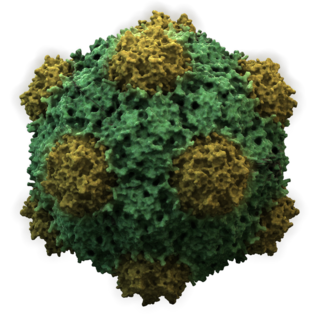
Comovirinae is a subfamily of viruses in the order Picornavirales, in the family Secoviridae; its genera were formerly classified in the family Comoviridae. Plants serve as natural hosts. There are currently 62 species in this subfamily, divided among 3 genera.
Tombusviridae is a family of single-stranded positive sense RNA plant viruses. There are currently 76 species in this family, divided among three subfamilies. The name is derived from the type species of the genus Tombusvirus, tomato bushy stunt virus (TBSV).
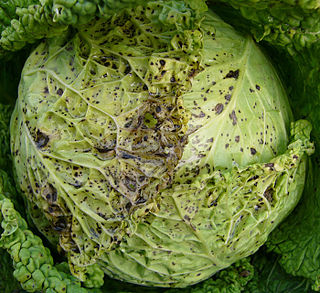
Tymoviridae is a family of single-stranded positive sense RNA viruses in the order Tymovirales. Plants serve as natural hosts. There are currently 41 species in this family, divided among three genera, with two species unassigned to a genus.

Tobamovirus is a genus of positive-strand RNA viruses in the family Virgaviridae. Many plants, including tobacco, potato, tomato, and squash, serve as natural hosts. Diseases associated with this genus include: necrotic lesions on leaves. The name Tobamovirus comes from the host and symptoms of the first virus discovered.

Potyvirus is a genus of viruses in the family Potyviridae. Plants serve as natural hosts. There are currently 183 species in this genus including the type species Potato virus Y. The genus is named after the type virus. Potyviruses account for ~30% of the currently known plant viruses. Like begomoviruses, members of this genus may cause significant losses in agricultural, pastoral, horticultural and ornamental crops. More than 200 species of aphids spread potyviruses and most are from the subfamily Aphidinae.
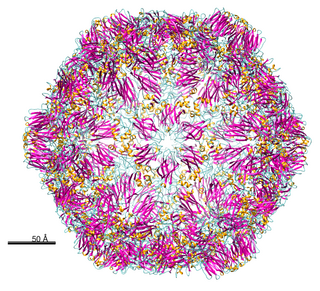
Nepovirus is a genus of viruses in the order Picornavirales, in the family Secoviridae, in the subfamily Comovirinae. Plants serve as natural hosts. There are currently 40 species in this genus including the type species Tobacco ringspot virus. Nepoviruses, unlike the other two genera in the subfamily Comovirinae, are transmitted by nematodes.

Partitiviridae is a family of double-stranded RNA viruses. Fungi and plants serve as natural hosts. The name comes from the Latin partitius, which means divided, and refers to the segmented genome of partitiviruses. There are 60 species in the family which are divided into five genera or unassigned to a genus.

Abacarus hystrix, the cereal rust mite or grain rust mite, belongs to the family Eriophyidae. They are extremely small with adults measuring up to 1 millimetre in length and only have four legs at the front of the body. Viewing by the human eye requires a 10 – 20X lens. The adult mites are usually yellow but also have been seen to be white or orange. The cereal rust mite was first found on Elymus repens, a very common perennial grass species. It has now been found on more than 60 grass species including oats, barley, wheat and ryegrass, found in Europe, North America, South Africa and Australia. Mites migrate primarily through wind movement and are usually found on the highest basal sections of the top two leaf blades. Abacarus hystrix produces up to twenty overlapping generations per year in South Australian perennial pastures, indicating that the species breeds quite rapidly. It has been noted that the cereal rust mite can cause losses in yield of up to 30-70%.

Sobemovirus is a genus of viruses. Plants serve as natural hosts. There are currently 14 species in this genus including the type species Southern bean mosaic virus. Diseases associated with this genus include: mosaics and mottles.

A virus is a submicroscopic infectious agent that replicates only inside the living cells of an organism. Viruses infect all types of life forms, from animals and plants to microorganisms, including bacteria and archaea. Since Dmitri Ivanovsky's 1892 article describing a non-bacterial pathogen infecting tobacco plants and the discovery of the tobacco mosaic virus by Martinus Beijerinck in 1898, more than 6,000 virus species have been described in detail of the millions of types of viruses in the environment. Viruses are found in almost every ecosystem on Earth and are the most numerous type of biological entity. The study of viruses is known as virology, a subspeciality of microbiology.

Secoviridae is a family of viruses in the order Picornavirales. Plants serve as natural hosts. There are currently 86 species in this family, divided among 8 genera or not assigned to a genus. The family was created in 2009 with the grouping of families Sequiviridae, now dissolved, and Comoviridae, now subfamily Comovirinae, along with the then unassigned genera Cheravirus, Sadwavirus, and Torradovirus.

Emaravirus is a genus of plant viruses and the sole genus in the family Fimoviridae. The genus has 11 species. The type species European mountain ash ringspot-associated emaravirus is associated with a leaf mottling and ringspot disease of European mountain ash Sorbus aucuparia. It can be transmitted by grafting and possibly mites.
Ribgrass mosaic virus (RMV) is a species of Tobamovirus. It is an RNA-containing virus with rod-shape particles. It can be found in many wild plant species. This virus does not itself produce serious epidemic diseases, but it served as the inciting pathogen of a necrotic virus disease in burly tobacco.
Polerovirus is a genus of viruses, in the family Luteoviridae. Plants serve as natural hosts. There are currently 26 species in this genus including the type species Potato leafroll virus. Diseases associated with this genus include: PLRV causes prominent rolling of the leaves of potato and a stiff upright habit of the plants; necrosis of the phloem and accumulation of carbohydrates in the leaves.
Rymovirus is a genus of viruses, in the family Potyviridae. Plants serve as natural hosts. There are currently three species in this genus including the type species Ryegrass mosaic virus.
Riboviria is a realm of viruses that includes all viruses that use a homologous RNA-dependent polymerase for replication. It includes RNA viruses that encode an RNA-dependent RNA polymerase; and, it includes reverse-transcribing viruses that encode an RNA-dependent DNA polymerase. RNA-dependent RNA polymerase (RdRp), also called RNA replicase, produces RNA from RNA. RNA-dependent DNA polymerase (RdDp), also called reverse transcriptase (RT), produces DNA from RNA. These enzymes are essential for replicating the viral genome and transcribing viral genes into messenger RNA (mRNA) for translation of viral proteins.
Orthornavirae is a kingdom of viruses that have genomes made of ribonucleic acid (RNA) and which encode an RNA-dependent RNA polymerase (RdRp). The RdRp is used to transcribe the viral RNA genome into messenger RNA (mRNA) and to replicate the genome. Viruses in this kingdom also share a number of characteristics involving evolution, including high rates of genetic mutations, recombinations, and reassortments.












